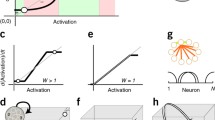Abstract
R.W. Ashby maintained that people and animals do not have to remember as much as one might think since considerable information is stored in the environment. Presented herein is an everyday, quantitative example featuring calculation of the number bits of memory that can be off-loaded to the environment. The example involves one’s storing directions to a friend’s house. It is also argued that the example works with or without acceptance of the extended mind hypothesis. Additionally, a brief supporting argument for at least a form of this hypothesis is presented.
Similar content being viewed by others
References
Ashby, R. (1956), An Introduction to Cybernetics, New York: Wiley.
Ashby, R. (1960), Design for a Brain: The Origin of Adaptive Behavior, second edition, New York: Wiley.
Clark, A. and Chalmers, D. (1998), 'The Extended Mind', Analysis 58, pp. 10–23. Reprinted in P. Grim, ed. (1998), The Philosopher's Annual, p. XXI.
Cormen, T., Leiserson, C., Rivest, R. and Stein, C. (2001), Introduction to Algorithms, second edition, Cambridge, MA: MIT Press.
Hutchins, E. (1995), Cognition in the Wild, Cambridge, MA: MIT Press.
Simon, H. (1981), The Sciences of the Artificial, second edition, Cambridge, MA: MIT Press.
Author information
Authors and Affiliations
Rights and permissions
About this article
Cite this article
Case, J. Off-Loading Memory to the Environment: A Quantitative Example. Minds and Machines 14, 387–389 (2004). https://doi.org/10.1023/B:MIND.0000035454.36558.55
Issue Date:
DOI: https://doi.org/10.1023/B:MIND.0000035454.36558.55




